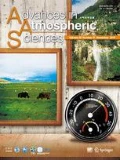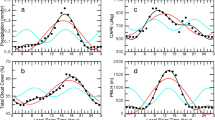Abstract
Using 32 CMIP5 (Coupled Model Intercomparison Project Phase 5) models, this study examines the veracity in the simulation of cloud amount and their radiative effects (CREs) in the historical run driven by observed external radiative forcing for 1850–2005, and their future changes in the RCP (Representative Concentration Pathway) 4.5 scenario runs for 2006–2100. Validation metrics for the historical run are designed to examine the accuracy in the representation of spatial patterns for climatological mean, and annual and interannual variations of clouds and CREs. The models show large spread in the simulation of cloud amounts, specifically in the low cloud amount. The observed relationship between cloud amount and the controlling large-scale environment are also reproduced diversely by various models. Based on the validation metrics, four models—ACCESS1.0, ACCESS1.3, HadGEM2-CC, and HadGEM2-ES—are selected as best models, and the average of the four models performs more skillfully than the multimodel ensemble average.
All models project global-mean SST warming at the increase of the greenhouse gases, but the magnitude varies across the simulations between 1 and 2 K, which is largely attributable to the difference in the change of cloud amount and distribution. The models that simulate more SST warming show a greater increase in the net CRE due to reduced low cloud and increased incoming shortwave radiation, particularly over the regions of marine boundary layer in the subtropics. Selected best-performing models project a significant reduction in global-mean cloud amount of about −0.99% K−1 and net radiative warming of 0.46 W m−2 K−1, suggesting a role of positive feedback to global warming.
摘要
本项研究使用32个CMIP5模式结果研究了云量及云辐射效应模拟的准确性,模式结果包括由辐射外强迫观测数据驱动的1850-2005历史试验以及未来中等强迫情景(RCP4.5)下2006-2100时段的变化.研究针对历史试验设计了评估指标,以此考察模式对于云及云辐射效应的气候平均态,年变化和年际变化的模拟准确性.研究结果表明:各个模式模拟的云量差异很大,尤其是低云量; 观测中云量与决定云量的大尺度环境场之间的关系在各个模式也有不同的表现.基于研究所得评估指标,选择了4个性能优异的模式,即ACCESS1.0, ACCESS1.3, HadGEM2-CC和HadGEM2-ES,它们的模拟技巧明显好于多模式集合平均结果.在温室气体增加的情景下,所有的模式均预测全球平均海表面温度会增加,但增幅并不相同,在1-2K之间变动,这主要是因为各个模式模拟的云量及其分布有所不同.海表面温度增暖幅度大的模式所模拟的净云辐射效应增加也更大,这是由于这些模式模拟的低云更少而入射海表的短波辐射更多,此现象在副热带海洋边界层区域表现得更加明显.所选的4个性能最好模式的预估结果显示:全球平均云量和净云辐射效应分别有近−0.99% K−1和0.46 W m−2 K−1的显著减少,这说明云的效应对全球变暖有正反馈作用.
Similar content being viewed by others
References
Andrews, T., J. M. Gregory, M. J. Webb, and K. E. Taylor, 2012: Forcing, feedbacks and climate sensitivity in CMIP5 coupled atmosphere-ocean climate models. Geophys. Res. Lett., 39(9), L09712, doi: 10.1029/2012GL051607.
Bony, S., and J.-L. Dufresne, 2005: Marine boundary layer clouds at the heart of tropical cloud feedback uncertainties in climate models. Geophys. Res. Lett., 32(20), L20806, doi: 10.1029/2005GL023851.
Bony, S., and Coauthors, 2006: How well do we understand and evaluate climate change feedback processes? J. Climate, 19, 3445–3482.
Clement, A. C., R. Burgman, and J. R. Norris, 2009: Observational and model evidence for positive low-level cloud feedback. Science, 325, 460–464, doi: 10.1126/science.1171255.
Dufresne, J. L., and S. Bony, 2008: An assessment of the primary sources of spread of global warming estimates from coupled atmosphere-ocean models. J. Climate, 21, 5135–5144.
Eastman, R., S. G. Warren, and C. J. Hahn, 2011: Variations in cloud cover and cloud types over the ocean from surface observations, 1954-2008, J. Climate, 24, 5914–5934.
George, R. C., and R. Wood, 2010: Subseasonal variability of low cloud radiative properties over the southeast Pacific Ocean. Atmospheric Chemistry and Physics, 10, 4047–4063, doi: 10.5194/acp-10-4047-2010.
Hartmann, D. L., L. A. Moy, and Q. Fu, 2001: Tropical convection and the energy balance at the top of the atmosphere. J. Climate, 14, 4495–4511.
IPCC, 2013: Climate Change 2013: The Physical Science Basis. Working Group I Contribution to the IPCC Fifth Assessment Report (AR5). Intergovernmental Panel on Climate Change, Geneva, Switzerland.
Klein, S. A., and D. L. Hartmann, 1993: The seasonal cycle of low stratiform clouds. J. Climate, 6, 1587–1606.
Klein, S. A., Y. Y. Zhang, M. D. Zelinka, R. Pincus, J. Boyle, and P. J. Gleckler, 2013: Are climate model simulations of clouds improving? An evaluation using the ISCCP simulator. J. Geophys. Res., 118, 1329–1342, doi: 10.1002/jgrd.50141.
Li, J.-L. F., D. E. Waliser, G. Stephens, S. Lee, T. L’Ecuyer, S. Kato, N. Loeb, and H.-Y. Ma, 2013: Characterizing and understanding radiation budget biases in CMIP3/CMIP5 GCMs, contemporary GCM, and reanalysis. J. Geophys. Res., 118, 8166–8184, doi: 10.1002/jgrd.50378.
Norris, J. R., and C. B. Leovy, 1994: Interannual variability in stratiform cloudiness and sea surface temperature. J. Climate, 7, 1915–1925.
Pavolonis, M. J., A. K. Heidinger, and T. Uttal, 2005: Daytime global cloud typing from AVHRR and VIIRS: Algorithm description, validation, and comparisons. J. Appl. Meteor., 44, 804–826, doi: 10.1175/JAM2236.1.
Platnick, S., M. D. King, S. A. Ackerman, W. P. Menzel, B. A. Baum, J. C. Riédi, and R. A. Frey, 2003: The MODIS cloud products: Algorithms and examples from Terra. IEEE Trans. Geosci. Remote Sens., 41(2), 459–473.
Ramanathan, V. and Coauthors, 1989: Cloud-radiative forcing and climate: Results from the earth radiation budget experiment, Science, 243, 57–63.
Randall, D. A., M. E. Schlesinger, V. Galin, V. Meleshko, J. J. Morcrette, and R. Wetherald, 2006: Cloud feedbacks. Frontiers in the Science of Climate Modeling, J. T. Kiehl and V. Ramanathan, Eds., Cambridge University Press.
Randall, D. A., and Coauthors, 2007: Climate models and their evaluation. The Physical Science Basis, Contribution of Working Group I to the Fourth Assessment Report of the Intergovernmental Panel on Climate Change, S. Solomon et al., Eds., Cambridge University Press, 589–662
Rayner, N. A., D. E. Parker, E. B. Horton, C. K. Folland, L. V. Alexander, D. P. Rowell, E. C. Kent, and A. Kaplan, 2003: Global analyses of sea surface temperature, sea ice, and night marine air temperature since the late nineteenth century. J. Geophys. Res., 108(D14), 4407, doi: 10.1029/2002JD 002670.
Rossow, W. B., and R. A. Schiffer, 1999: Advances in understanding clouds from ISCCP. Bull. Amer. Meteor. Soc., 80, 2261–2287.
Shin, S. H., M. I. Lee, and O. Y. Kim, 2014: Examinations of cloud variability and future change in the coupled model intercomparison project phase 3 simulations. Asia-Pacific Journal of Atmospheric Sciences, 50(4), 481–495.
Soden, B. J., and I. M. Held, 2006: An assessment of climate feedbacks in coupled ocean-atmosphere models. J. Climate, 19, 3354–3360.
Stephens, G. L., 2005: Cloud feedbacks in the climate system: A critical review. J. Climate, 18, 237–273.
Taylor, K. E., R. J. Stouffer, and G. A. Meehl, 2012: An overview of CMIP5 and the experiment design. Bull. Amer. Meteor. Soc., 93, 485–498.
Uppala, S. M., and Coauthors, 2005: The ERA-40 re-analysis. Q. J. R. Meteorol. Soc., 131, 2961–3012.
Vial, J., J.-L. Dufresne, and S. Bony, 2013: On the interpretation of inter-model spread in CMIP5 climate sensitivity estimates. Climate Dyn., 41, 3339–3362.
Waliser, D. E., and Coauthors, 2009: Cloud ice: A climate model challenge with signs and expectations of progress. J. Geophys. Res., 114(D8), D00A21, doi: 10.1029/2008JD010015.
Webb, M. J., and Coauthors, 2006: On the contribution of local feedback mechanisms to the range of climate sensitivity in two GCM ensembles. Climate Dyn., 27, 17–38.
Wood, R., and D. L. Hartmann, 2006: Spatial variability of liquid water path in marine low cloud: The importance of mesoscale cellular convection. J. Climate, 19, 1748–1764.
Worley, S. J., S. D. Woodruff, R. W. Reynolds, S. J. Lubker, and N. Lott, 2005: ICOADS release 2.1 data and products. Inter. J. Climatol., 25, 823–842, doi: 10.1002/joc.1166.
Wyant, M. C., C. S. Bretherton, H. A. Rand, and D. E. Stevens, 1997: Numerical simulations and a conceptual model of the stratocumulus to trade cumulus transition. J. Atmos. Sci., 54, 168–192.
Wyant, M. C., C. S. Bretherton, J. T. Bacmeister, J. T. Kiehl, I. M. Held, M. Zhao, S. A. Klein, and B. J. Soden, 2006: A comparison of low-latitude cloud properties and their response to climate change in three AGCMs sorted into regimes using midtropospheric vertical velocity. Climate Dyn., 27, 261–279.
Yeh, S.-W., Y.-G. Ham, and J.-Y. Lee, 2012: Changes in the Tropical Pacific SST trend from CMIP3 to CMIP5 and its implication of ENSO. J. Climate, 25, 7764–7771.
Zelinka, M. D., S. A. Klein, and D. L. Hartmann, 2012a: Computing and partitioning cloud feedbacks using cloud property histograms. Part I: Cloud radiative kernels. J. Climate, 25, 3715–3735, doi: 10.1175/JCLI-D-11-00248.1.
Zelinka, M. D., S. A. Klein, and D. L. Hartmann, 2012b: Computing and partitioning cloud feedbacks using cloud property histograms. Part II: Attribution to changes in cloud amount, altitude, and optical depth. J. Climate, 25, 3736–3754, doi: 10.1175/JCLI-D-11-00249.1.
Zelinka, M. D., S. A. Klein, K. E. Taylor, T. Andrews, M. J. Webb, J. M. Gregory, and P. M. Forster, 2013: Contributions of different cloud types to feedbacks and rapid adjustments in CMIP5. J. Climate, 26, 5007–5027, doi: 10.1175/JCLI-D-12-00555.1.
Acknowledgements
The authors thank Joel NORRIS for providing the adjusted ISCCP data. The CMIP5 data were obtained from the data archive (http://cmip-pcmdi.llnl.gob/cmip5/index.html). This research was supported by the APEC Climate Center. ML and DK were supported by the UNIST research fund (Grant No. 1.09006.01). Additional support was provided by a grant (Grant No. 14AWMP-B082564-01) from the Advanced Water Management Research Program funded by the Ministry of Land, Infrastructure and Transport of the Korean government.
Author information
Authors and Affiliations
Corresponding author
Rights and permissions
About this article
Cite this article
Shin, SH., Kim, OY., Kim, D. et al. Cloud radiative effects and changes simulated by the Coupled Model Intercomparison Project Phase 5 models. Adv. Atmos. Sci. 34, 859–876 (2017). https://doi.org/10.1007/s00376-017-6089-3
Received:
Revised:
Accepted:
Published:
Issue Date:
DOI: https://doi.org/10.1007/s00376-017-6089-3




